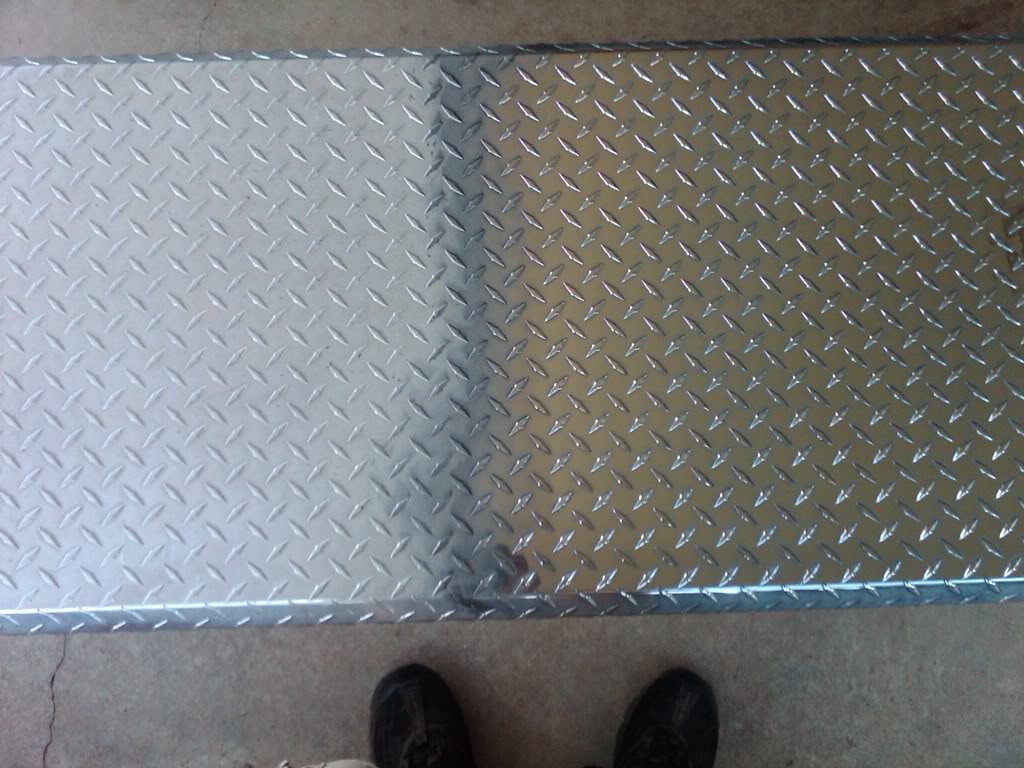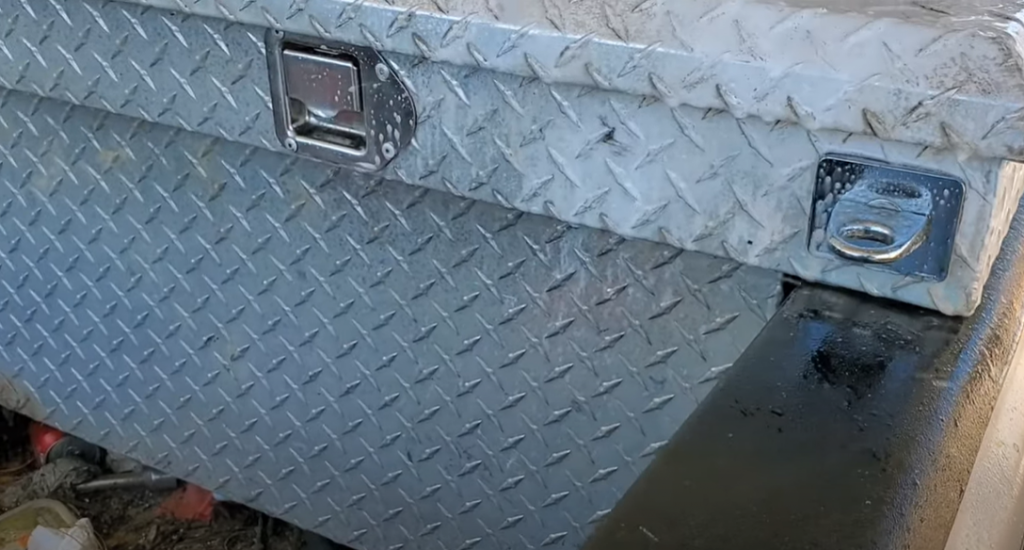Introduction
How To Clean Aluminum Tool Box : Aluminum tool boxes are popular for their durability, lightweight nature, and resistance to corrosion. However, over time, they can accumulate dirt, grime, and oxidation, which can dull their appearance.

In this article, we will provide you with step-by-step instructions on how to effectively clean and restore the shine of your aluminum tool box. We will cover various cleaning methods, including both homemade solutions and commercial aluminum cleaners, ensuring that you have multiple options to choose from based on your preferences and available resources.
We will discuss the necessary materials and tools required for the cleaning process, as well as safety precautions to take. Our guide will also address specific cleaning techniques for different levels of dirt and oxidation, allowing you to tailor the approach to your specific tool box.
Whether you’re a DIY enthusiast, a professional tradesperson, or simply someone looking to maintain the appearance of your aluminum tool box, this guide will equip you with the knowledge and techniques to achieve a clean and vibrant result. Let’s dive in and bring back the luster to your aluminum tool box.
What can I use to clean my aluminum toolbox?
Wet your aluminum tool box with plain water. Use a soft, nylon bristle scrub brush and dip it into soapy water. Scrub the surface of your aluminum tool boxes to remove dirt on the surface. Rinse with water until all the soap is gone.
When it comes to cleaning your aluminum toolbox, there are several options available to you. Here are some common materials and cleaners that can be effective in cleaning and restoring the appearance of your aluminum toolbox:
Mild Soap and Water: Start by using a mixture of mild dish soap and warm water. Dip a soft cloth or sponge into the soapy water and gently scrub the surface of the toolbox. This method is suitable for removing light dirt and grime.
Vinegar Solution: Mix equal parts of white vinegar and water to create a cleaning solution. Apply the solution to a cloth or sponge and wipe down the toolbox. Vinegar is effective in removing stubborn stains and oxidation from the aluminum surface.
Baking Soda Paste: Create a paste by mixing baking soda with water. Apply the paste to a cloth or sponge and scrub the toolbox in a circular motion. The mild abrasive properties of baking soda help to remove tougher stains and bring back the shine.
Aluminum Cleaner: There are commercial aluminum cleaners available in the market specifically formulated for cleaning and brightening aluminum surfaces. Follow the manufacturer’s instructions and use the cleaner as directed.
Metal Polish: If your aluminum toolbox has scratches or dull areas, you can use a metal polish product to restore its shine. Apply the polish to a clean cloth and rub it onto the surface in circular motions. Then, buff the area with a separate clean cloth to achieve a polished finish.
What’s the best way to clean aluminum?
Mix one part of vinegar or lemon juice with one part of warm water in a bowl to create a cleaning solution. Next, dip a clean cloth into the mixture and use it to wipe down the aluminum. Be sure to scrub any areas that are particularly dirty or stained.
The best way to clean aluminum depends on the specific item and the level of dirt or oxidation present. However, here is a general approach for cleaning aluminum.
Start by rinsing the aluminum item with water to remove loose debris and dirt.
Use a mild soap or a specialized aluminum cleaner. Apply the cleaner to a soft cloth or sponge and gently scrub the aluminum surface. Avoid abrasive materials that can scratch the metal.
For tougher stains or oxidation, you can create a paste using a mixture of water and baking soda. Apply the paste to the aluminum surface and gently scrub in circular motions with a soft cloth. Rinse thoroughly afterward.
For stubborn stains or corrosion, you may need to use a non-abrasive metal polish. Apply the polish to a clean cloth and buff the affected areas. Follow the instructions on the polish carefully.
Rinse the aluminum item thoroughly with water to remove any residue from the cleaning products.Dry the aluminum completely with a clean, soft cloth to prevent water spots.
Remember to always test any cleaning solution or product on a small, inconspicuous area before applying it to the entire surface. This helps ensure compatibility and prevents any unwanted damage or discoloration.
What is the best tool to clean aluminum with?
It is generally better to apply using a non-abrasive sponge or soft cloth as aluminum can scratch easily during the cleaning process. Rinse well. Because of its flexibility, this particular method is great for cleaning aluminum furniture and other objects too large to move.
When it comes to cleaning aluminum, the best tool to use depends on the specific task at hand. Here are a few tools that are commonly used for cleaning aluminum:
Soft Cloth or Sponge: A soft cloth or sponge is a versatile tool that can be used for general cleaning of aluminum surfaces. It is gentle on the metal and helps to remove light dirt and grime.
Soft-Bristled Brush: For tougher stains or harder-to-reach areas, a soft-bristled brush can be effective. Choose a brush with non-abrasive bristles to avoid scratching the aluminum surface.
Microfiber Cloth: Microfiber cloths are excellent for cleaning aluminum as they are soft, lint-free, and highly absorbent. They can help remove fingerprints, smudges, and bring out the shine of the metal.
Toothbrush: A toothbrush can be handy for cleaning small or intricate areas of aluminum items. The bristles help to scrub away dirt and grime, especially in corners or crevices.
Air Compressor or Compressed Air: If you have access to an air compressor or canned compressed air, it can be useful for blowing away dust, debris, or loose particles from the aluminum surface. This is particularly effective for cleaning aluminum fins or delicate areas where physical contact may not be suitable.
Remember to choose tools that are non-abrasive to avoid scratching the aluminum. Additionally, consider the specific cleaning task and the sensitivity of the aluminum surface to determine the most appropriate tool for the job.
What not to clean aluminium with?
To prevent a build-up of grime and food particles in your aluminum sink, regularly clean the surface with dish soap, a sponge, and warm water. Avoid scrubbing the sink with abrasive brushes or pads, so you don’t damage the soft metal.
When cleaning aluminum, it’s important to avoid using certain cleaners or tools that can potentially damage or corrode the metal. Here are some things to avoid when cleaning aluminum:
Abrasive Cleaners: Stay away from abrasive cleaners or scrubbing pads that can scratch the surface of the aluminum. This includes steel wool, wire brushes, or harsh scouring powders, as they can leave permanent marks on the metal.
Acidic Cleaners: Avoid using cleaners that contain acidic ingredients like vinegar, lemon juice, or citrus-based cleaners. These acidic substances can cause discoloration, etching, or corrosion on the aluminum surface.
Strong Alkalis: Similarly, strong alkalis such as caustic soda or lye should be avoided. These substances can also corrode or damage the aluminum.
Ammonia-based Cleaners: While ammonia-based cleaners can be effective for some surfaces, they are not recommended for aluminum. Ammonia can cause discoloration and tarnishing of the metal.
Metal or Wire Brushes: Metal or wire brushes, especially those made of steel or other hard metals, should be avoided as they can scratch and damage the aluminum surface.
High-Pressure Washers: Avoid using high-pressure washers on aluminum as the force of the water can cause dents, scratches, or even strip away protective finishes.
To ensure the safe and effective cleaning of aluminum, opt for gentle cleaners specifically designed for aluminum surfaces. Always read the manufacturer’s instructions and test any new cleaner on a small, inconspicuous area before applying it to the entire surface. Additionally, use soft cloths, sponges, or non-abrasive brushes for cleaning to minimize the risk of scratching or damaging the aluminum.
What are some effective methods for cleaning an aluminum tool box and restoring its shine?
There are several effective methods for cleaning an aluminum tool box and restoring its shine. Here are a few techniques you can try:
Soap and Water: Start by mixing a mild dish soap or aluminum-safe cleaner with warm water. Use a soft cloth or sponge to gently scrub the aluminum surface, removing dirt and grime. Rinse thoroughly with water and dry with a clean cloth.
Vinegar Solution: Create a solution by mixing equal parts of white vinegar and water. Apply the solution to the aluminum surface using a cloth or sponge. The vinegar helps to remove oxidation and restore shine. Rinse well with water and dry thoroughly.
Baking Soda Paste: Make a paste by combining baking soda with water. Apply the paste to a soft cloth or sponge and gently scrub the aluminum surface in circular motions. Baking soda helps remove stains and bring back the shine. Rinse and dry the toolbox afterward.
Aluminum Cleaner: There are specialized aluminum cleaners available in the market. Follow the instructions provided by the manufacturer. Typically, you’ll apply the cleaner to the surface, let it sit for a specified time, and then rinse it off thoroughly.
Metal Polish: Use a suitable metal polish product designed for aluminum surfaces. Apply the polish to a clean cloth and buff the aluminum surface in circular motions. This helps to remove stains, oxidation, and restore shine. Follow the product instructions carefully.
Always test any cleaning solution or method on a small, inconspicuous area of the aluminum tool box before applying it to the entire surface. This ensures compatibility and avoids potential damage. Regular cleaning and maintenance of the aluminum tool box will help preserve its appearance and extend its lifespan.
Can you provide step-by-step instructions on how to clean an aluminum tool box using household items?
Certainly! Here’s a step-by-step guide on how to clean an aluminum tool box using household items:
Gather your materials: You’ll need mild dish soap, warm water, a soft cloth or sponge, vinegar, baking soda, and a clean cloth for drying.
Prepare the cleaning solution: Fill a bucket or basin with warm water and add a small amount of mild dish soap. Mix it well until the soap is dissolved.
Rinse the tool box: Use a hose or running water to rinse off loose dirt and debris from the aluminum tool box.
Wash the tool box: Dip the soft cloth or sponge into the soapy water and gently scrub the entire surface of the aluminum tool box. Pay extra attention to areas with stains or dirt buildup. For stubborn spots, you can apply gentle pressure while scrubbing.
Remove oxidation with vinegar: For areas with oxidation, dampen a cloth with vinegar and rub it onto the affected spots. Vinegar helps to dissolve oxidation and restore shine. Rinse the tool box thoroughly with water afterward.
Tackle stubborn stains with baking soda: Create a paste by mixing baking soda with a small amount of water. Apply the paste to a cloth or sponge and gently scrub the stains in circular motions. Baking soda’s mild abrasive properties will help lift tough stains. Rinse well.
Rinse and dry: Once you have cleaned the entire tool box, rinse it thoroughly with clean water to remove any soap residue. Use a clean cloth to dry the aluminum tool box completely. This step is crucial to prevent water spots and maintain its shine.
Following these steps will help you effectively clean your aluminum tool box using common household items. Remember to test any cleaning solution or method on a small, inconspicuous area first and always handle the tool box with care to avoid any damage.

Are there any specialized cleaners available for cleaning aluminum tool boxes? How do they work?
Yes, there are specialized cleaners available for cleaning aluminum tool boxes. These cleaners are specifically formulated to tackle the unique characteristics of aluminum and are designed to effectively remove dirt, oxidation, stains, and restore shine. They typically work through a combination of chemical reactions and cleaning agents. Here’s an overview of how they work:
Aluminum-Safe Cleaners: These cleaners are specifically formulated to be safe and effective for use on aluminum surfaces. They often contain ingredients that help break down and lift dirt, grime, and oxidation without causing harm to the metal. Follow the instructions provided by the manufacturer for the specific cleaner you choose.
Acid-Based Cleaners: Some specialized aluminum cleaners contain mild acids like phosphoric acid or citric acid. These acids help dissolve oxidation and stains on the surface of the aluminum. They work by reacting with the oxide layer, breaking it down, and allowing it to be easily wiped away.
Abrasive Cleaners: Certain aluminum cleaners may have mild abrasives included in their formulation. These abrasives help to mechanically remove stubborn stains or oxidation from the surface of the aluminum. The abrasives gently scrub away the buildup while being careful not to scratch the metal.
When using specialized cleaners, it is essential to follow the instructions provided by the manufacturer. This includes applying the cleaner to the aluminum surface, allowing it to work for the specified time, and then rinsing it off thoroughly. Be sure to test the cleaner on a small, inconspicuous area of the tool box first to ensure compatibility and avoid any potential damage. Always use specialized cleaners in a well-ventilated area and wear appropriate protective gloves if recommended by the manufacturer.
What are the common challenges or stains that can be encountered when cleaning an aluminum tool box, and how can they be addressed?
When cleaning an aluminum tool box, you may encounter various challenges and stains. Here are some common ones and how they can be addressed:
Dirt and Grime: Regular use can lead to the accumulation of dirt and grime on the surface of the tool box. To address this, start by rinsing the tool box with water, then use a mild soap or aluminum-safe cleaner with a soft cloth or sponge to gently scrub away the dirt. Rinse thoroughly and dry the tool box afterward.
Oxidation: Aluminum can develop a layer of oxidation, which appears as a dull or discolored surface. To address oxidation, you can use specialized aluminum cleaners that contain acid or vinegar. Apply the cleaner, allow it to sit for the recommended time, and then scrub the surface gently. Rinse well with water and dry thoroughly.
Water Stains: If your aluminum tool box has water spots or mineral deposits, they can be challenging to remove. You can try using a mixture of equal parts vinegar and water, or a specialized aluminum cleaner, to dissolve and remove the stains. Apply the solution, let it sit for a few minutes, scrub gently, rinse, and dry thoroughly.
Grease or Oil Stains: Grease or oil stains can be stubborn on an aluminum tool box. To address these, use a mild dish soap or a specialized degreaser. Apply the cleaner, scrub gently with a soft cloth or sponge, and rinse thoroughly. For stubborn stains, you may need to repeat the process or use a stronger degreasing agent.
Scratches: Scratches on the aluminum surface can be a cosmetic concern. While they may not affect the functionality of the tool box, you can minimize their appearance by using a metal polish. Apply the polish to a soft cloth and buff the scratched areas in circular motions. This can help blend and reduce the visibility of the scratches.
Remember to always test any cleaning method or product on a small, inconspicuous area before applying it to the entire surface. This helps ensure compatibility and avoids potential damage to the tool box.

Conclusion
Throughout this guide, we have explored various methods for cleaning aluminum tool boxes, including using household items such as mild soap, vinegar, baking soda, and specialized aluminum cleaners. We have also discussed common challenges like dirt, oxidation, water stains, grease, and scratches, providing solutions for addressing each of them.
Remember to always prioritize safety, read manufacturer instructions, and conduct a patch test before applying any cleaning solution or method to the entire tool box. Additionally, regular maintenance and prompt cleaning of your aluminum tool box will help prevent the buildup of dirt, grime, and oxidation.
By implementing the techniques outlined in this guide, you can keep your aluminum tool box in optimal condition, ensuring it remains functional, visually appealing, and a reliable companion for your tools.


